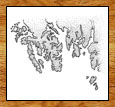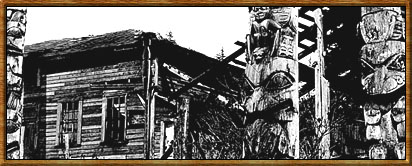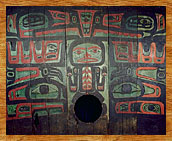 
|
Howkan

Howkan is first mentioned by John Work as being a sizable town of 458 inhabitants. The name is a Tlingit one. Ensign Alfred P. Niblack, who explored the coast of Alaska for the U.S. Navy, claims that the original inhabitants of the camp called Kaigani moved their winter residence to Howkan. Some remained at the small village of Koianglas just below Howkan but were in the process of amalgamating with Howkan when he observed them. Niblack claims that in 1886 Howkan was thriving and had a winter population of about three hundred.
During the last twenty years of the previous century, photographs recorded rapid changes in the houses and poles throughout the village. Perhaps the most radical change, but one that took place in stages, can be seen in Chief Skowl's house. He was town chief of both Howkan and Kasaan. His house in Howkan sat near the centre of town. After he died in the winter of 1882-83, his successor lost no time in adding a second storey to the house by putting joists through the roof and building a European-style cottage on top, complete with a balcony and gingerbread trim. He also added milled lumber and five windows to the facade of the old house.
The pole in front of Chief Skowl's house has a naturalistic American eagle on the top, flanked by two traditional watchmen. Below that is a figure of the Czar of Russia with flowing locks and a beard. He wears a coat with epaulets and stands between the ears of the Thunderbird that sports an incredible display of plumage on its head, wings, breast, tail and even its feet. At the base, a standing Bear holds an insect in its mouth. In the 1940s, the pole was taken to Ketchikan, where it was placed in the midst of traffic beside a tunnel. The location is perhaps the worst setting imaginable for a cultural treasure such as this.
Another remarkable pole was erected next door to Chief Skowl's house in about 1885. A photo of the pole, taken much later, depicts its intricately detailed interlocking figures.
The graveyard at Howkan is perhaps the most elaborate of any Haida village. Its most photographed feature is a large figure of a Sea Grizzly with two dorsal fins, whose massive size and smooth lines preserved it from the weather for many years. A second notable feature of this cemetery is a painted interior screen, similar to one collected by George T. Emmons from Howkan and now in the Canadian Museum of Civilization. At the same time, he acquired a memorial pole for the collection of Lord Bossom in London which was repatriated to the Canadian Museum of Civilization in the 1960s after Lord Bossom's death.

 |
Carved and painted screens such as this one were used to separate the chief's compartment from the rest of the household. The circular doorway is between the legs of an ancestor, protected by the Raven in human form. Above him is Raven in two profiles. Eagles stand on a large rock that is depicted as a living creature with a mouth and eye. This is the only surviving Haida interior screen.
Acquired in Howkan village, Alaska, by George T. Emmons for the Lord Bossom collection.
CMC VII-B-1527 (S86-21) |

|